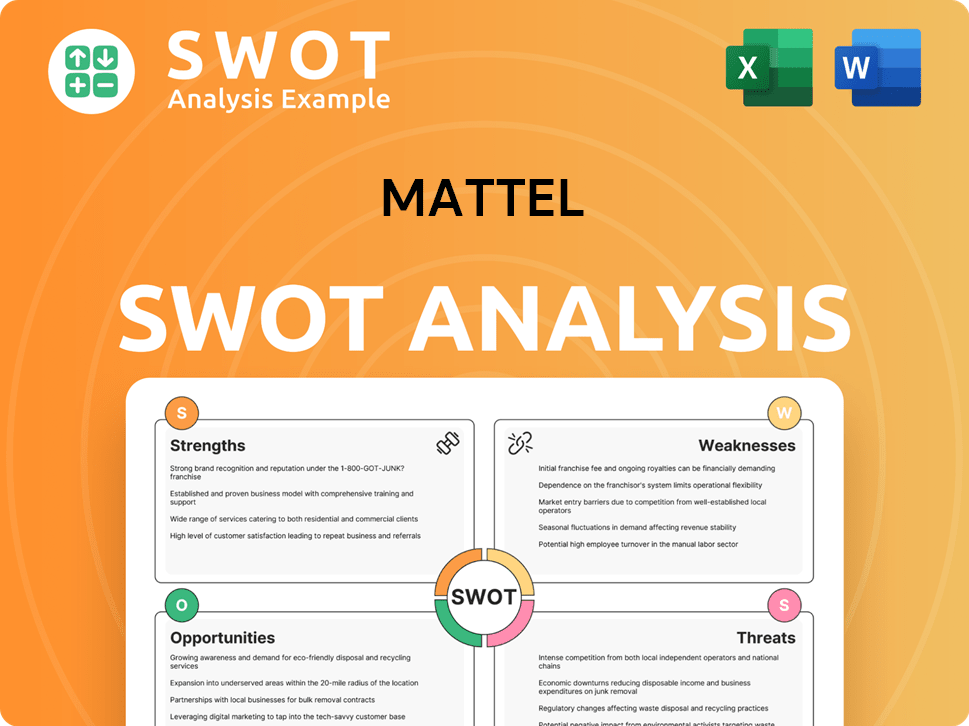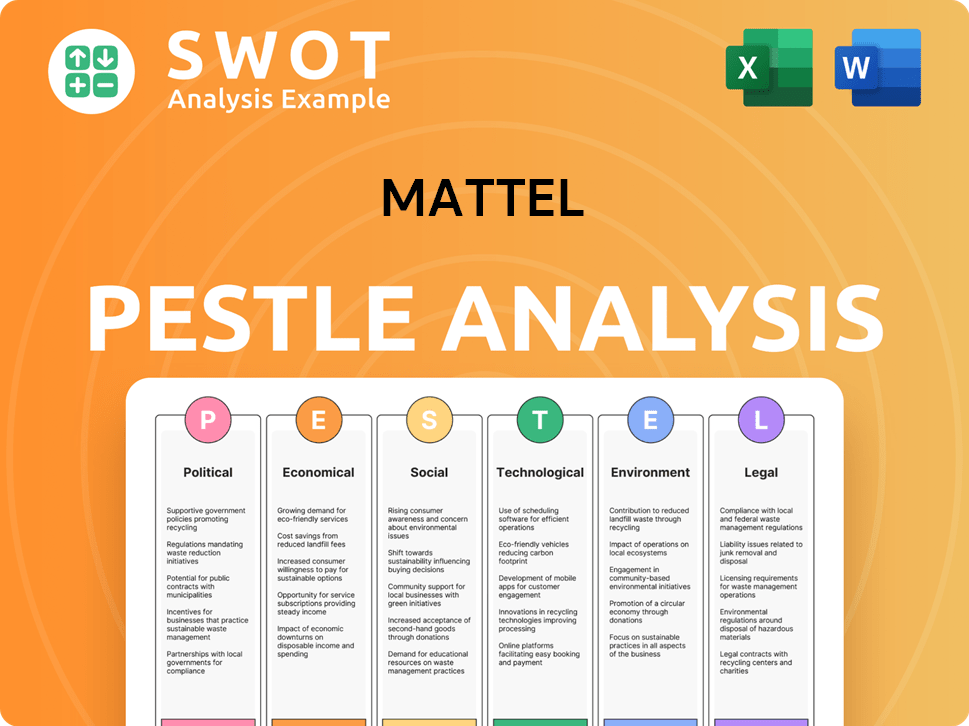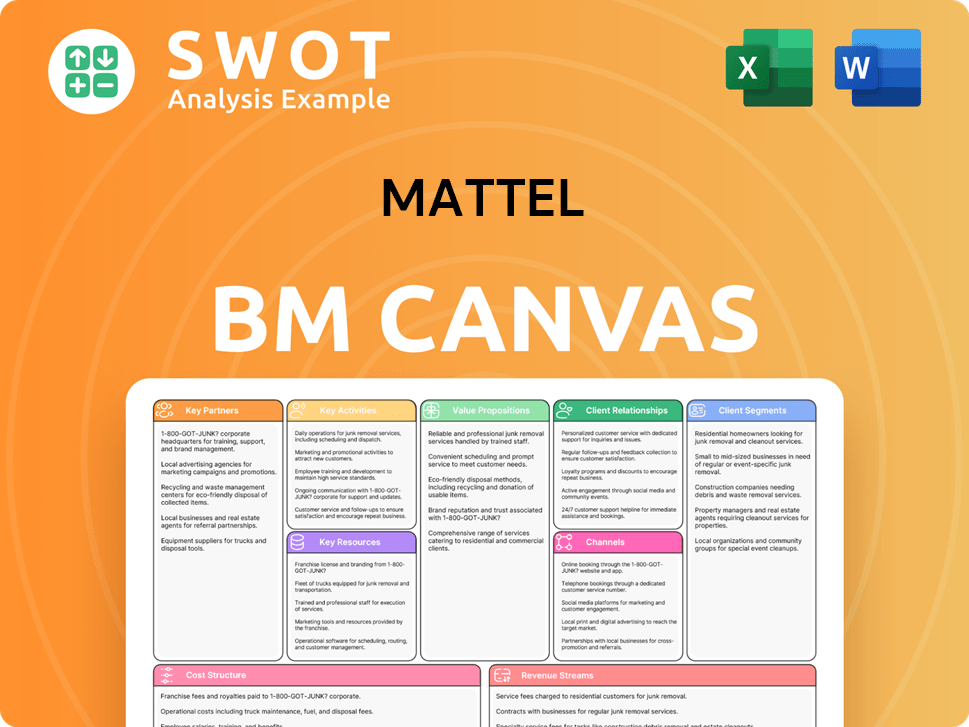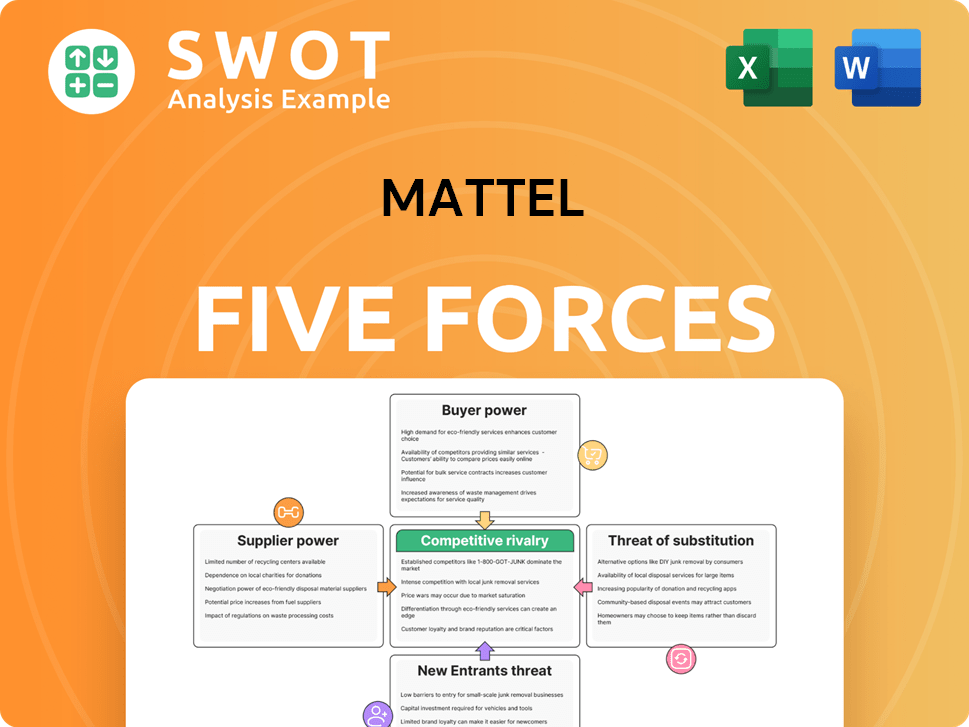Mattel Bundle
Can Mattel Maintain Its Dominance in the Toy Industry?
The global toy industry is a dynamic battleground, constantly reshaped by innovation and shifting consumer preferences. Mattel, a titan of this industry, faces relentless competition. This analysis delves into the Mattel SWOT Analysis, examining its competitive landscape and market position.

Understanding Mattel's competitive landscape is crucial for investors and industry watchers alike. This exploration will dissect Mattel's main rivals in the toy market, analyze its competitive advantage, and evaluate its strategic responses to evolving consumer trends and competitor innovation. We'll also examine Mattel's market share and financial performance compared to key competitors, providing a comprehensive Mattel market analysis.
Where Does Mattel’ Stand in the Current Market?
Within the dynamic toy industry, the company maintains a prominent market position, consistently ranking among the leading global players. The Mattel competitive landscape is shaped by its iconic brand portfolio and strategic adaptations to consumer trends.
The company's core operations revolve around the design, manufacturing, and distribution of toys and related products. Their value proposition centers on delivering innovative and engaging play experiences for children worldwide, supported by strong brand recognition and a diverse product range. In 2023, the company reported net sales of $5.44 billion, demonstrating its substantial presence in the market.
The company's strength lies in its diverse and iconic brand portfolio, which includes category leaders such as Barbie (the number one doll property globally), Hot Wheels (the number one toy vehicle property globally), and Fisher-Price (a leading brand in infant and preschool toys).
The company holds a significant portion of the global toy market, competing closely with Hasbro. Mattel's market share fluctuates, but it consistently ranks among the top players. The company's strong brand recognition and diverse product range contribute to its competitive advantage.
The company's product lines include dolls, vehicles, infant and preschool toys, and action figures. This diverse portfolio caters to a broad demographic, from infants to collectors. Mattel's global market share by product category reflects its strong presence across various segments.
The company has a strong global presence, with sales distributed across North America, Europe, Latin America, and Asia Pacific. This well-diversified market reach helps to mitigate risks and capitalize on growth opportunities. The company continues to seek growth in emerging markets.
The company has demonstrated resilience, with a healthy balance sheet and continued investment in innovation and brand development. The company has focused on improving profitability and cash flow, aiming for sustained growth. For more insights, check out the Owners & Shareholders of Mattel.
The company adapts to changing consumer trends by expanding into digital content and experiences. This includes digital games, animated series, and live-action films, such as the successful Barbie movie in 2023. Competitive strategies of Mattel involve innovation and brand development to maintain its competitive edge.
- Focus on Digital Expansion: Investing in digital games, animated series, and films to engage modern consumers.
- Brand Development: Continued investment in iconic brands like Barbie and Hot Wheels.
- Geographic Expansion: Targeting growth in emerging markets and digital platforms.
- Financial Management: Improving profitability and cash flow for sustained growth.
Mattel SWOT Analysis
- Complete SWOT Breakdown
- Fully Customizable
- Editable in Excel & Word
- Professional Formatting
- Investor-Ready Format

Who Are the Main Competitors Challenging Mattel?
The Mattel competitive landscape is intensely shaped by the global toy market's dynamics, where the company faces both direct and indirect competition. Understanding Mattel's market analysis involves assessing its position against major players and emerging trends. The company's ability to maintain and grow its Mattel's market share depends on its competitive strategies and adaptability.
Navigating the toy industry requires continuous innovation, effective marketing, and strategic partnerships. The competitive environment is constantly evolving, influenced by consumer preferences, technological advancements, and economic factors. This article provides insights into Mattel competitors and the strategies they employ.
The competitive environment for the company is multifaceted, involving both direct and indirect rivals. The company's strategic decisions and operational effectiveness are crucial for maintaining and improving its position in the market. For more details on the company's overall strategy, consider reading about the Growth Strategy of Mattel.
The primary direct competitor is Hasbro, a global toy and entertainment giant. Hasbro's diverse portfolio includes brands like Nerf, Play-Doh, and Monopoly, which directly compete with the company in various toy segments. The competition between the two often involves licensing agreements and marketing campaigns.
LEGO Group is a significant direct competitor, particularly in the construction toy category. LEGO's strong brand recognition and product innovation indirectly compete for children's playtime and parental spending. LEGO's market presence continues to grow.
MGA Entertainment, known for its L.O.L. Surprise! and Bratz dolls, poses a significant challenge, especially to the company's Barbie brand. MGA's ability to innovate and capture market share in the doll category makes it a key competitor. The company constantly evolves its product lines.
Spin Master, with brands like Paw Patrol and Hatchimals, is a notable competitor, especially in the innovative and collectible toy categories. Spin Master's success in creating engaging and popular toys makes it a key player in the market. The company's focus on innovation drives its competitive edge.
Indirect competitors include video game companies like Nintendo, Sony, and Microsoft, which compete for children's entertainment time. Streaming services such as Disney+ and Netflix also offer content that competes with traditional toys. These platforms impact how children spend their time.
Smaller companies leveraging crowdfunding or direct-to-consumer models disrupt traditional distribution. These companies often introduce niche or tech-infused toys, changing the competitive landscape. Their agility and innovation pose ongoing challenges.
The company's competitive landscape is shaped by factors such as licensing agreements, product innovation, and marketing campaigns. The company's strategies to gain market share involve focusing on key brands, expanding into new categories, and adapting to changing consumer trends. Understanding the strengths and weaknesses of competitors is crucial.
- Licensing Agreements: Securing and managing licenses for popular characters and brands is a key strategy.
- Product Innovation: Developing new and engaging products, including tech-infused toys, is essential.
- Marketing Campaigns: Effective marketing campaigns are crucial for brand visibility and consumer engagement.
- Distribution Channels: Utilizing both traditional and digital channels to reach consumers.
Mattel PESTLE Analysis
- Covers All 6 PESTLE Categories
- No Research Needed – Save Hours of Work
- Built by Experts, Trusted by Consultants
- Instant Download, Ready to Use
- 100% Editable, Fully Customizable

What Gives Mattel a Competitive Edge Over Its Rivals?
The competitive landscape for toy companies is dynamic, and understanding the strengths and weaknesses of key players like Mattel is crucial for any market analysis. Examining the strategies of Mattel's competitors, alongside its own initiatives, offers insight into the broader toy industry. Key milestones and strategic moves shape the competitive edge of companies like Mattel, influencing their market share and financial performance.
Analyzing Mattel's market position involves assessing its product portfolio, distribution channels, and responses to competitor innovation. The company's ability to adapt to changing consumer trends and leverage its competitive advantages, such as brand equity and global distribution, is critical. Understanding how Mattel compares to Hasbro and other rivals provides a comprehensive view of the toy industry's competitive dynamics.
Mattel's competitive advantages are significant, stemming from its iconic brands, extensive intellectual property, and robust global distribution network. These strengths allow the company to maintain a strong position in the toy market. The company's success is also influenced by economic factors and its strategies to gain market share, making it a key player in the industry. For further insights into the consumer base, consider exploring the Target Market of Mattel.
Mattel's portfolio includes globally recognized brands like Barbie, Hot Wheels, and Fisher-Price. These brands have cultivated decades of consumer trust and loyalty, resulting in significant pricing power. The enduring appeal of Barbie, for example, demonstrates the immense value of Mattel's brand assets, supporting a strong competitive advantage.
Proprietary technologies and intellectual property, including patents for toy mechanisms and design innovations, provide Mattel with a barrier against imitation. The company continuously invests in research and development to introduce novel play experiences. This focus on innovation helps maintain product freshness and competitive differentiation.
Mattel's extensive global distribution network, reaching over 150 countries, allows efficient delivery to diverse markets. This broad reach provides a significant logistical advantage over smaller competitors. Strong relationships with major retailers worldwide further enhance distribution capabilities.
Economies of scale in manufacturing and procurement enhance Mattel's cost efficiency, enabling competitive pricing and healthier profit margins. The company's diverse talent pool fosters a culture of innovation and creativity, essential for sustained product development. These advantages contribute to Mattel's overall market competitiveness.
Mattel's primary competitive advantages include strong brand recognition, extensive intellectual property, and a robust global distribution network. These factors enable Mattel to maintain a leading position in the toy industry. The company's ability to leverage these strengths is crucial for sustained success.
- Brand Recognition: Iconic brands like Barbie and Hot Wheels drive consumer loyalty.
- Intellectual Property: Patents and design innovations create barriers to entry.
- Global Distribution: A vast network reaching over 150 countries.
- Economies of Scale: Efficient manufacturing and procurement processes.
Mattel Business Model Canvas
- Complete 9-Block Business Model Canvas
- Effortlessly Communicate Your Business Strategy
- Investor-Ready BMC Format
- 100% Editable and Customizable
- Clear and Structured Layout

What Industry Trends Are Reshaping Mattel’s Competitive Landscape?
The Mattel competitive landscape is significantly influenced by evolving industry trends, presenting both challenges and opportunities. The toy industry is experiencing a shift towards digital integration, sustainability, and content-driven sales. These factors shape how companies like Mattel strategize and innovate to maintain their market position. For a deeper understanding, you can refer to Brief History of Mattel.
Mattel's market analysis reveals a dynamic environment where the company must navigate economic fluctuations, changing consumer preferences, and technological advancements. The company's ability to adapt to these factors will be crucial for its future success. Understanding the competitive dynamics and the strategies of Mattel competitors is essential for assessing its long-term viability.
The toy industry is seeing a rise in digital and physical play integration, with augmented reality (AR) and artificial intelligence (AI) enhancing play experiences. Sustainability and ethical production are becoming increasingly important to consumers. Content, including movies and shows, plays a significant role in driving toy sales, influencing consumer choices.
Competition from digital entertainment, supply chain disruptions, and rising production costs pose challenges. Declining demand in certain traditional toy categories and increased scrutiny over product safety are also significant issues. Aggressive new competitors in niche markets add to the competitive pressure.
Emerging markets offer significant growth opportunities due to rising disposable incomes and growing demand for branded toys. Product innovations, especially in tech-infused and sustainable toys, provide avenues for differentiation. Strategic partnerships with entertainment companies can expand market reach and brand relevance.
Mattel focuses on strengthening its core brands, expanding into new consumer segments, and leveraging content creation to drive toy sales. The company invests in digital transformation, sustainable practices, and global market expansion. These strategies aim to maintain Mattel's market share and competitive advantage.
Mattel is focusing on digital transformation, which includes enhancing its e-commerce capabilities and integrating digital elements into its products. The company is also investing in sustainable practices, such as using recycled materials and reducing its carbon footprint. Mattel aims to expand its global market presence, particularly in emerging markets like China and India, to drive growth. In 2023, Mattel's gross sales were approximately $5.44 billion, showing resilience in a challenging market. The company's focus on cost optimization and strategic brand management has helped it navigate economic pressures.
- Mattel's focus on innovation is evident in its development of tech-infused toys and sustainable product lines.
- Strategic partnerships with entertainment companies, such as collaborations on licensed products, continue to be a key growth driver.
- The company's financial performance is closely tied to its ability to adapt to changing consumer preferences.
- Mattel is continually evaluating its competitive strategies to maintain its position in the global toy market.
Mattel Porter's Five Forces Analysis
- Covers All 5 Competitive Forces in Detail
- Structured for Consultants, Students, and Founders
- 100% Editable in Microsoft Word & Excel
- Instant Digital Download – Use Immediately
- Compatible with Mac & PC – Fully Unlocked

Related Blogs
- What are Mission Vision & Core Values of Mattel Company?
- What is Growth Strategy and Future Prospects of Mattel Company?
- How Does Mattel Company Work?
- What is Sales and Marketing Strategy of Mattel Company?
- What is Brief History of Mattel Company?
- Who Owns Mattel Company?
- What is Customer Demographics and Target Market of Mattel Company?
Disclaimer
All information, articles, and product details provided on this website are for general informational and educational purposes only. We do not claim any ownership over, nor do we intend to infringe upon, any trademarks, copyrights, logos, brand names, or other intellectual property mentioned or depicted on this site. Such intellectual property remains the property of its respective owners, and any references here are made solely for identification or informational purposes, without implying any affiliation, endorsement, or partnership.
We make no representations or warranties, express or implied, regarding the accuracy, completeness, or suitability of any content or products presented. Nothing on this website should be construed as legal, tax, investment, financial, medical, or other professional advice. In addition, no part of this site—including articles or product references—constitutes a solicitation, recommendation, endorsement, advertisement, or offer to buy or sell any securities, franchises, or other financial instruments, particularly in jurisdictions where such activity would be unlawful.
All content is of a general nature and may not address the specific circumstances of any individual or entity. It is not a substitute for professional advice or services. Any actions you take based on the information provided here are strictly at your own risk. You accept full responsibility for any decisions or outcomes arising from your use of this website and agree to release us from any liability in connection with your use of, or reliance upon, the content or products found herein.